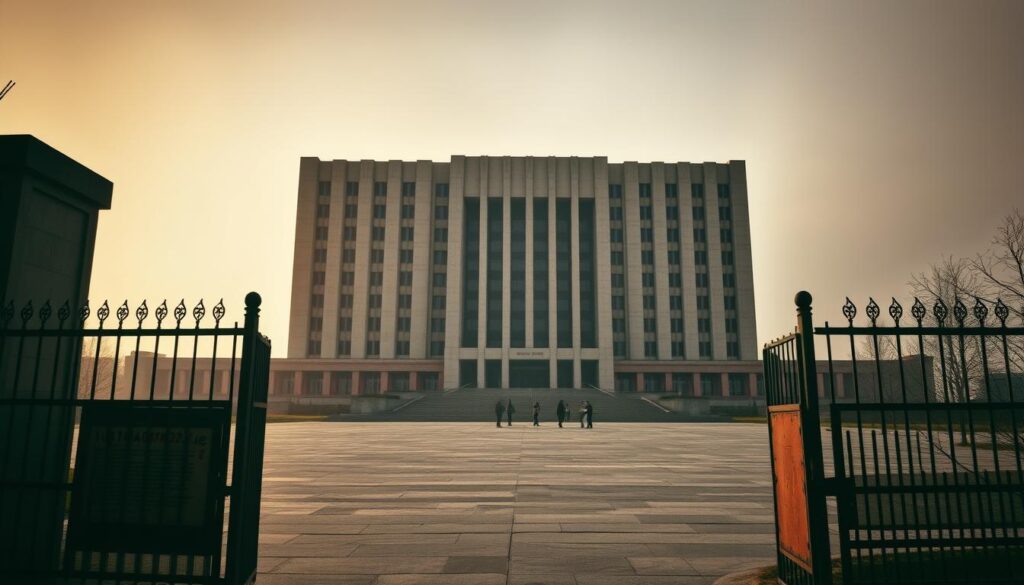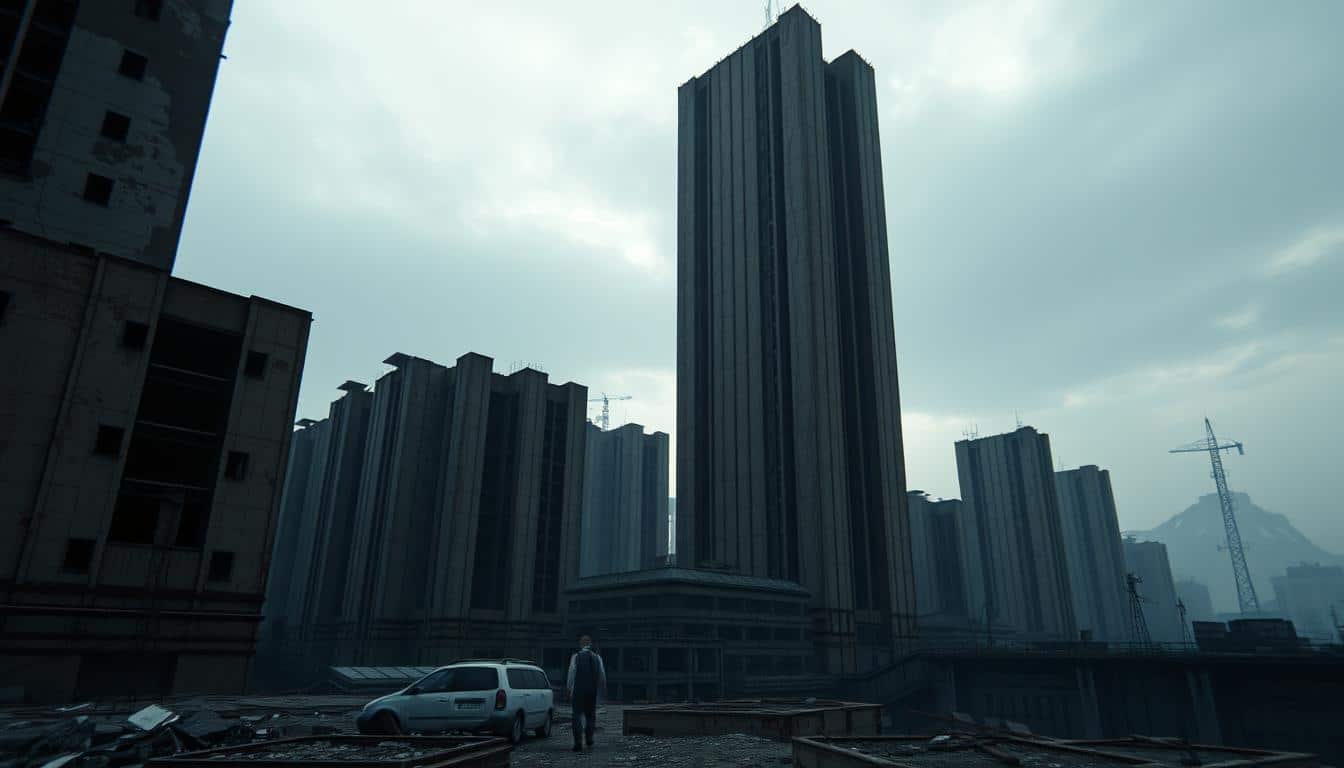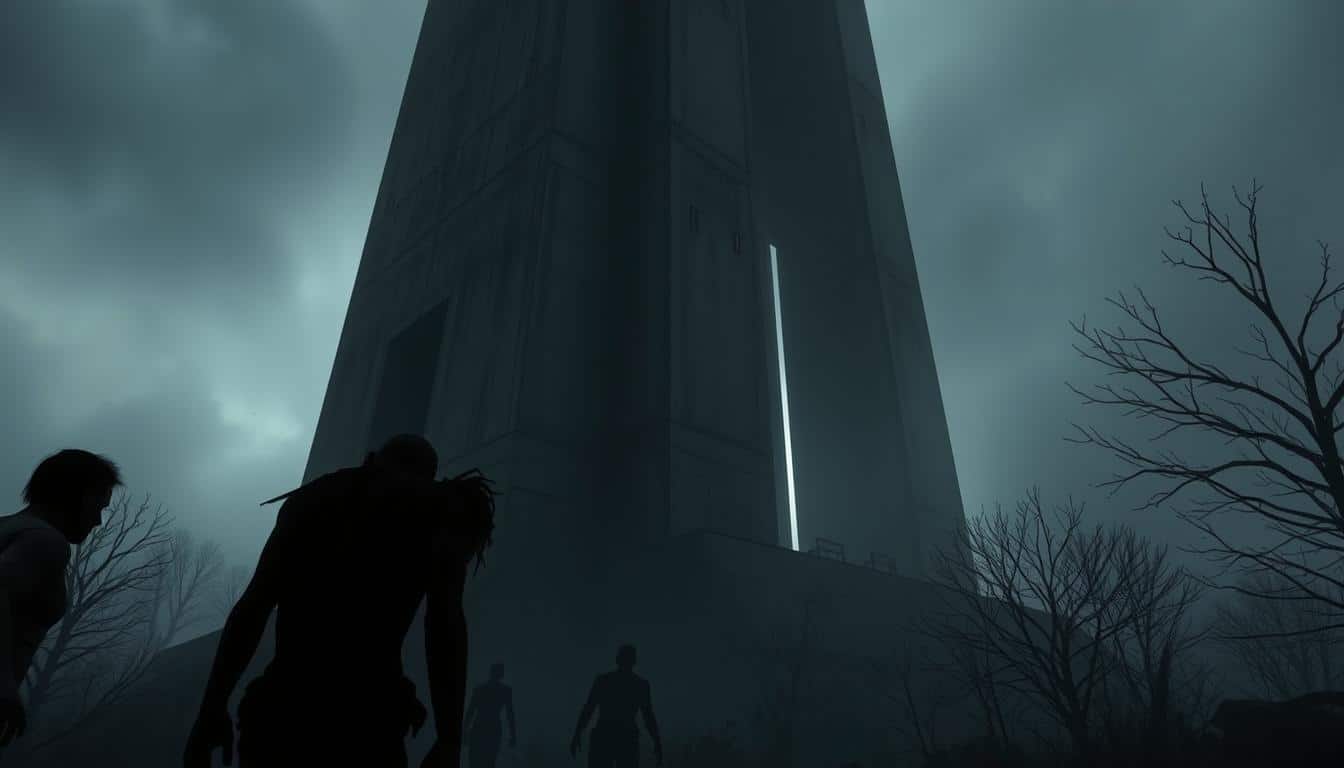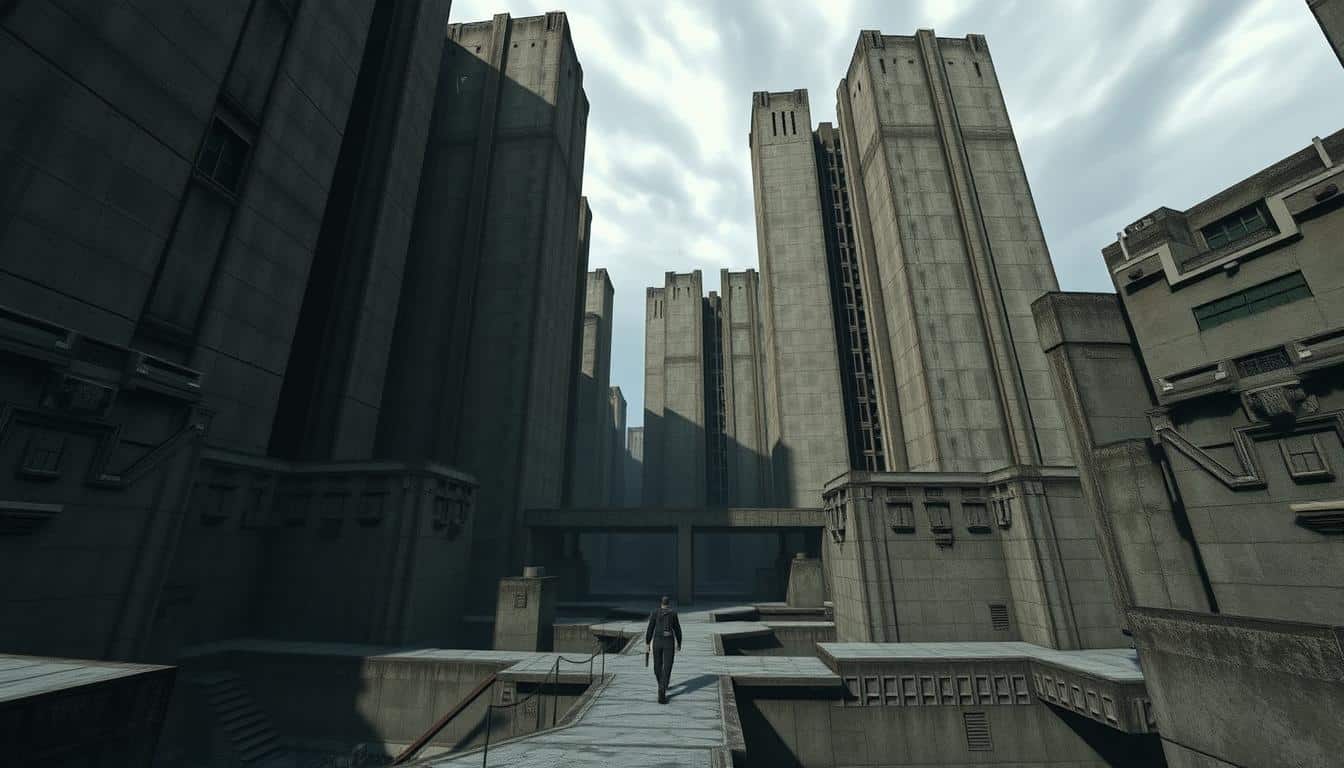Soviet brutalist design started after World War II. It’s known for big buildings, raw concrete, and a simple, functional look. The style is based on “béton brut” or raw concrete. Its goal is to keep things serious, simple, and useful. Now, it’s not just about buildings anymore. This style has moved into video game art. As more games use brutalism, they get a unique look. This makes game levels, stories, and play experience more engaging. Players get to explore places that feel grand but strict, just like brutalist architecture. We’ll show you how games are using Soviet brutalism to create amazing virtual worlds.
Introduction to Soviet Brutalism
The history of Soviet brutalism started after World War II. This movement arose as cities needed to rebuild quickly. Architects chose simple shapes and cheap materials for urban development.
Soviet brutalism showed the time’s socio-political atmosphere. It focused on functionality and living together. This post-war architecture met housing and public space needs. It also shared an ideology to change society. The look of brutalism, with its simple forms and raw materials, showed Soviet ideals.

This architectural style’s long-lasting charm comes from its deep sense of history and place. It deals with identity and heritage in rebuilding cities. Today, the ideas behind Soviet brutalism still influence modern architecture and design.
Characteristics of Soviet Brutalist Design
Soviet brutalist design is known for its bold concrete buildings. These structures are more about function than looks. Their raw materials shout about the big architecture they’re part of. This style grabs your attention with its huge designs that make you feel powerful.
This kind of design loves simple shapes. You’ll see repeating patterns and clear lines that make city life seem less complicated. The rough textures give the buildings character, highlighting their bare beauty. These features make the buildings stand out, echoing the values of that time.
Soviet brutalism was about creating a new kind of architecture during big changes. It aimed to bring people together, mirroring the era it came from. These grand buildings were a symbol of hope and unity, despite the tough times they were built in.
The Influence of Brutalist Architecture on Video Games
Brutalist architecture has a big role in video games. Its unique features shape many parts of game design. This style helps build virtual worlds that attract both game makers and players. Using simple, raw materials in game settings makes a strong visual statement. It also makes games more emotionally engaging.
Brutalism fits well with modern gaming looks. It lets creators make worlds that encourage exploring and interacting. In these games, concrete buildings and clear lines often point players in the right direction. They help tell the game’s story through the environment. This mix of architecture and game play shows how brutalist ideas deepen the game experience.
Game makers are pushing this architectural style into all types of games. From action-packed shooters to thoughtful puzzle games. By adding brutalist design, they make games that break the usual rules. This leads to exciting worlds where the look of the game is as important as its story.
Understanding Soviet Brutalist Design Elements in Video Game Art
Soviet brutalism’s essence shines through in video game art. Games use exposed concrete, sharp angles, and deep shadows for immersive worlds. These design elements do more than just look cool. They change how players interact with the story and setting.
How Brutalism Translates into Virtual Worlds
Brutalist design in video games creates unique experiences. In these games, giant, blocky buildings make the world feel huge and imposing. This approach mixes gameplay with real-feel architecture, making every level believable and well-designed. The shadows from these big buildings heighten emotions, making players feel alone or on edge, fitting the game’s mood.
Iconic Examples of Brutalism in Game Design
Some famous games perfectly blend Soviet brutalist style into their design. “NaissanceE” and “Control” use these design ideas to tell stories better. “NaissanceE” uses simple, stark settings to make players want to explore. “Control” uses the unique shapes of the Oldest House to change how the game plays. These games stand out because they take architectural concepts and turn them into unforgettable gaming experiences.
The Aesthetic Appeal of Brutalism in Gaming
Brutalism in gaming draws players with its bold and raw beauty. Games show off large, simple structures that make you feel everything from wonder to fear. This creates a special setting that pulls players into the game more deeply.
Brutalist games have a special way of making players feel connected. When you move through these amazing digital places, it changes how you see beauty. Exploring these games makes you think deeply about their design.
These game worlds make you focus on being alone and thinking deeply. The look of the game mixed with how you play makes the experience stick with you. It turns gaming into something powerful and memorable.
Notable Games Featuring Soviet Brutalist Elements
Video games show us many architectural styles, like Soviet Brutalism. A key game is “Control” by Remedy Entertainment. It shows us how brutalist buildings can change gameplay and the story.
Case Study: Control and the Oldest House
“Control” has a place called the Oldest House. It’s a great example of brutalist design in the game. Its huge, heavy look helps create a special feel. It feels like it’s part of the game’s story.
As players move through the game, they see how the buildings change their view. The Oldest House, with its big concrete walls and complex design, makes players think more deeply. It’s like another character that helps tell the story.
In “Control,” the Oldest House’s design links to the game’s big ideas. These include power, bureaucracy, and strange events. This connection changes how players see their virtual world. It shows that the setting can greatly affect how we experience games.
Emerging Titles Showcasing Brutalist Designs
Indie games are thriving, with new titles that challenge traditional design and storytelling. A striking trend is the embrace of brutalism in gaming. This move inspires creators to build experiences reflecting the stark, unembellished look of Soviet architecture. Games like “BRUTALIST” stand out, inviting players into minimalist settings inspired by a deep architectural history.
These games go beyond copying brutalist structures. They weave in novel design features that stir feelings of deep thought and ambiance. The drive behind this trend is the aim to immerse players. It offers vast spaces for exploration and reflection.
The indie gaming world is undergoing a brutalism renaissance. It draws players into settings that fuse stark beauty with simplicity. The following traits underscore this trend in new games:
- Geometric shapes and sharp lines create eye-catching landscapes.
- Light and shadow play together, bringing emotional layers to the settings.
- Atmospheric sounds match the minimalist visual style, enhancing the experience.
As games continue to explore brutalism, the concept grows, captivating varied audiences. This blend of architecture and interactive media charts new paths for creative design, enlivening the realm of digital arts.
The Role of Artistic Expression in Video Game Environments
Artistic expression is crucial when making video game worlds. These areas are not just for looks; they make the story feel real. Game makers use styles like brutalism to create a bond between players and the games they play. This approach makes the game’s setting tell part of the story, revealing deeper meanings and character arcs.
Brutalist architecture’s unique features deeply affect how players get into the game’s story. Big, stark buildings can make you feel alone or in awe, pulling you further into the tale. This blend of art and gameplay helps players do more than just move through a world. They fully dive into the story.
Game worlds often shape how players see things and react. Brutalism’s sharp lines and simple materials make you notice the scenery, adding to the story’s mood. This partnership between design and storytelling boosts the feelings games stir up. This makes gaming not just fun but a rich artistic experience.
Conclusion
Brutalist designs in video games do more than just look cool. They make stories richer and more engaging. When games use these bold concrete styles, they create worlds that feel real and emotional. Every piece of the environment adds to the story, making the adventure unforgettable.
The stark, bold look of Soviet brutalism brings a special touch to games. It connects the player’s actions to the game’s world in a unique way. This special connection fits perfectly with the game’s larger story.
Game developers are now really into the raw beauty of brutalism. This style is all about trying new things and mixing old game ideas with new designs. As our tech gets better, we have even more chances to use different designs in games. This will make games feel more real and touch players’ hearts.
The use of brutalist design in games opens up new ways for creators to tell stories and show emotions. Mixing these designs with game actions offers unforgettable experiences. Even after the game ends, its impact stays with players. This keeps the conversation about brutalism in gaming alive and exciting.



